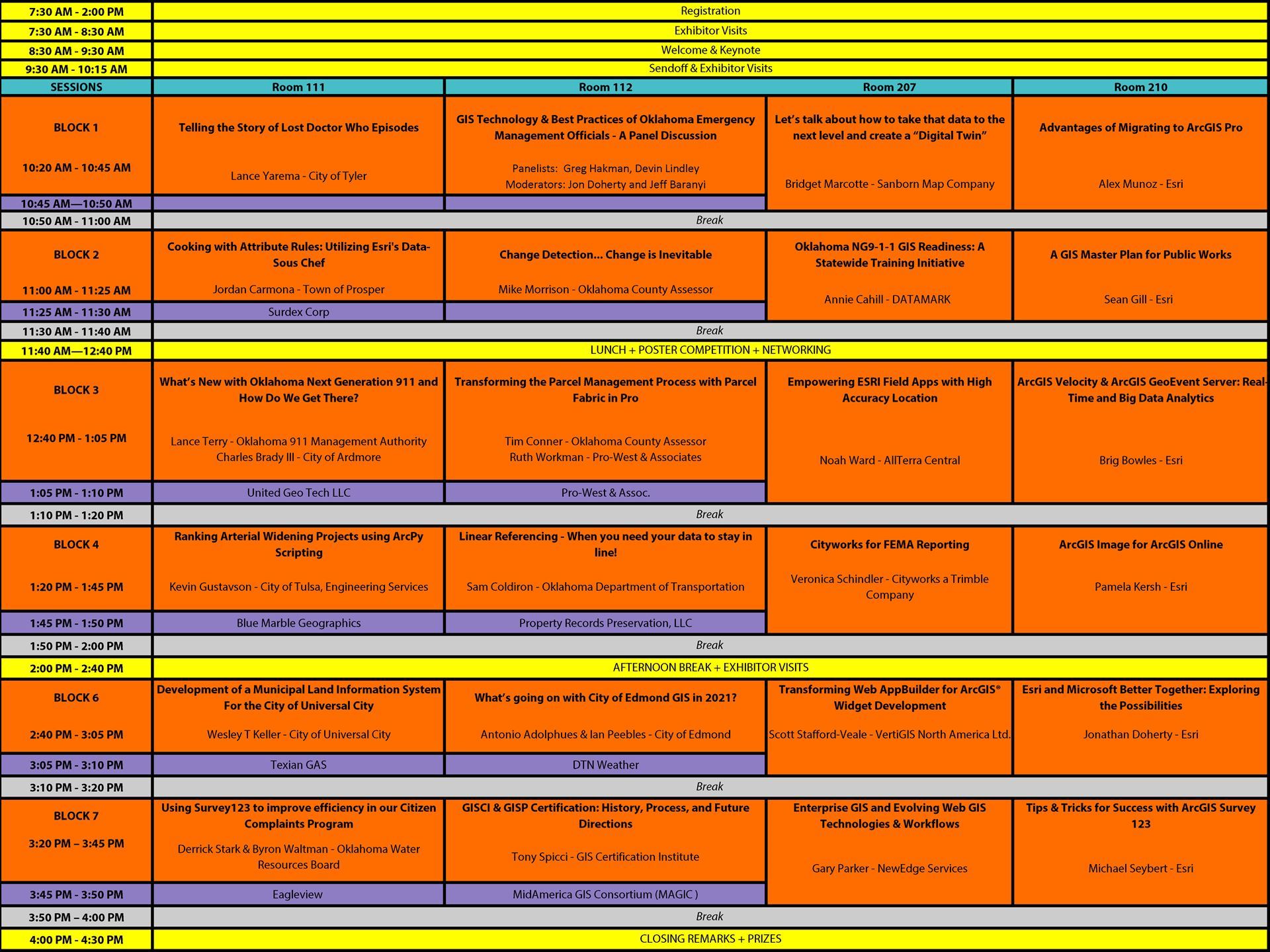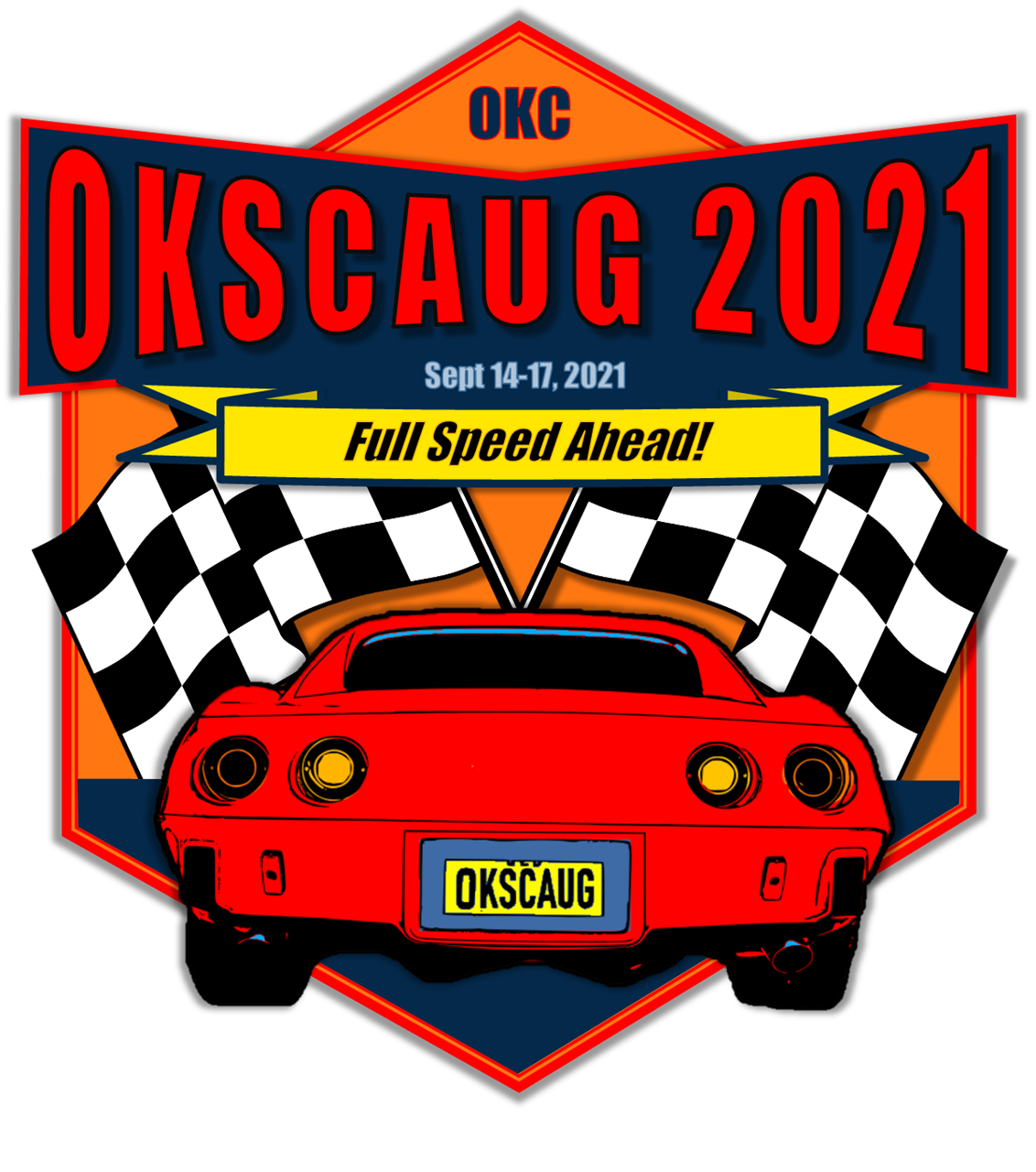Presentation times can be found in the Conference Agenda and inside the Conference App.


Change Detection... Change is Inevitable Mike Morrison - Oklahoma County Assessor All seventy-seven counties in Oklahoma are required by statute to physically examine properties on a four-year inspection cycle. The Oklahoma County Assessor’s Office simulated a project to discover if geo-referenced polygons could be used to detect changes for variances in real estate. APEX software, Oklahoma County’s sketch vendor, converted our sketches to polygons, also known as “building footprints”. These footprints were then geo-referenced over the current high resolution aerial imagery. This process resulted in high efficiency in recognizing the changes on properties for both major and minor variances. Along with confirming overall accuracy of our parcel data, it gave status to other variances like “pool” and “additional building”. Our GIS technicians went through a multi-tiered process to convert the received database in ArcPro to KMZ [zipped] (keyhole mapping language; KML) and then exported the output file types and format to be compatible with our current aerial viewer provided by Nearmap Software. Using ArcGIS Pro, we took point files referencing certain locations, status, and converted them into polygons. The different status was color coded, sorted into layers, creating a clearer distinction between layers and status for field appraisers that could be easily recognized. Because of the large file size of the entire county variances, we separated status into their prospective townships and further separated the status into individual layers. The data was then made available to our field appraisers to load on their personal accounts in the Nearmap viewer. This showed us the proof of concept we needed to move forward. However, our internal process was time consuming. This encouraged our office to seek further streamlining of this change detection procedure by exploring GeoViewPort, a mapping cloud service provided by our vendor iLOOKABOUT. This vendor used our color-coding system from the original data conversion process which created an easy transition to the new software while capturing the same efficiency and accuracy. Utilizing our results in easily recognizable layers, this process guided our work in a “user friendly” format for the vendor to duplicate without the need of loading individual layers to an account. The GeoViewport cloud service can represent layers and shapes in the format required to continue the assessment process in a timely manner. Thankfully our vendors were able to work in conjunction with our office to provide the appraisers with a superior product that can be used in our office or out in the field. Thank you for your help and support: iLookabout, Nearmap, Apex, ESRI, Patriot, and Prognose. | Transforming the Parcel Management Process with Parcel Fabric in Pro Tim Conner - Oklahoma County Assessor Ruth Workman - Pro-West & Associates Learn how Oklahoma County converted its parcel data from CAD to Esri’s Parcel Fabric in ArcGIS Pro with the goal of creating accurate data and eliminating inefficiency in the county’s map production process. During the session we will share:
| Linear Referencing - When you need your data to stay in line! Sam Coldiron - Oklahoma Department of Transportation Linear Referencing is a method of locating physical features or data along a known linear asset. How do I find an intersection when all I know is that it's 3.2 miles down Highway 1? How do I find Valve 'ABC' when all I know is that it's 6,000 meters down Pipeline Gamma. Linear Referencing allows you to build out a network of routes, pipelines, railways, power line, rivers, etc. and locate data along them using the distance or measures along those features. This presentation will give you an overview of Linear Referencing and some common applications of it. |
What’s going on with City of Edmond GIS in 2021? Antonio Adolphues & Ian Peebles - City of Edmond The City of Edmond continues to make great progress towards expanding the capabilities of Geographic Information Systems (GIS) technology. This presentation provides an overview of GIS technology use within the City of Edmond and focuses specifically on the geodatabase, desktop applications, web applications, application integration, data hub, custom tools and automating process workflows. Challenges of introducing new technology are discussed. This presentation concludes with covering the future road map of GIS within the organization. | Telling the Story of Lost Doctor Who Episodes Lance Yarema - City of Tyler GIS is used in many fields like utilities, public safety, land development, and more, but what about applying it to pop culture? One particular genre in British pop culture is Doctor Who, the world's longest running sci-fi series. Most people are familiar with the series, but many do not realize some of the early episodes are missing from the BBC's archive. Over the decades, missing episodes have been recovered all around the world! This presentation is divided into two sections. The first section gives a synopsis of the history of why these episodes are missing. The second provides the meats and potatoes of using GIS to map the recovery locations by using StoryMaps. | GIS Technology & Best Practices of Oklahoma Emergency Management Officials - A Panel Discussion Greg Hakman - City of Midwest City Devin Lindley - Choctaw Nation of Oklahoma Jon Doherty - Esri (Panel Moderator) Jeff Baranyi - Esri (Panel Moderator) Join Oklahoma State and Local Government emergency management officials, along with members of the ESRI Public Safety team to discuss data sharing and collaboration best practices. In this discussion, our presenters will discuss how they use location technology to support situational awareness in the field (Damage Assessment), incident command posts, and emergency operations centers. |
Cooking with Attribute Rules: Utilizing Esri's Data-Sous Chef Jordan Carmona - Town of Prosper
While it is true that you can't make an [actionable] omelette without [data entry]-ing a few eggs, modern spatio-culinary techniques allow us to whip up datasets with ease. Esri's Attribute Rules provide methods to knead, chop, and whisk away the labor of manually mincing your data. We'll be sifting through examples of attribute rules, peeling back their logic, and clarifying an approach to tackling new recipes. Come into the kitchen, sharpen your [Arcade], and watch as this [data]monger reveals Esri's 11 secret herbs and spices. | GISCI & GISP Certification: History, Process, and Future Directions Tony Spicci - GIS Certification Institute This presentation will cover the current GISP process, including the Portfolio requirements and the Exam structure and content. This session will focus on the value and growth of GIS professional certification and where GISCI and the GISP certification will go from here. | Ranking Arterial Widening Projects using ArcPy Scripting Kevin Gustavson - City of Tulsa, Engineering Services The City of Tulsa’s “Transportation Improvement Projects Prioritization Plan” allows city engineers to objectively rank arterial road segments for widening through an approved scoring system using criteria in 11 categories. In the past, an engineer has filled out hundreds of numbers in an Excel spreadsheet to arrive at project rankings. Now, the automation and scripting capabilities of GIS drives the process once the necessary layers of data are gathered or created. Scripts iterate through each arterial road segment, search for relevant data from other map layers, and manipulate and store the updated data in the feature class table. Another script calculates subscores for each category and final scores as outlined in the prioritization plan. Finally, the feature class table is exported to Excel for ranking and review by the engineers. In the end, what was an excruciating task for a project engineer is now largely automated, saving a tremendous amount of effort and time. |
Development of a Municipal Land Information System For the City of Universal City Wesley T Keller - City of Universal City Over a three year period, the City of Universal City has developed a Land Information System. The system provides information for parcels with the City limits. Information includes physical address, zip code, county clerks office volume and page, recordation date, a legal description, AICUZ status, gas provider service area, sewer provider service area, zoning, lot square footage, legal acreage, DBA, structure square footage, construction year, number of stories, number of rooms, school district, legal instrument type, police district, alternate name (AKA), DACA number, AICUZ tract number, geographic ID, parcel ID, and code compliance zone. Links to PDFs of legal documents are also provided. The system is hosted on ArcGIS Online and integrated with a content management system (CMS) called Publitas. This presentation will show the historical development of the system and give a brief demonstration. | Using Survey123 to improve efficiency in our Citizen Complaints Program Derrick Stark & Byron Waltman - Oklahoma Water Resources Board The Oklahoma Water Resources Board’s Citizen Complaints program allows citizens to bring to our attention specific rule violations in water use permitting, water well drilling and pump installation, dam safety, and floodplain management. Previously citizens filed complaints through a form that was downloaded from our website and mailed or faxed in, or by calling in directly. To streamline this process and to provide staff investigating the complaints a way to view them on a map, we used Survey123 to create an online form that citizens can use to report their complaints. Another benefit is the ability to cross-reference the complaint location with existing GIS data. This presentation will go over the process of building the survey that helped make our complaints process more accessible for the public as well as more efficient. | What’s New with Oklahoma Next Generation 911 and How Do We Get There? Lance Terry - Oklahoma 911 Management Authority Charles Brady III - City of Ardmore This presentation will focus on an overview of the latest developments with Oklahoma Next Generation 911. Topics will include a discussion of the recent GIS 911 Training Courses, the use of the NG911 GIS Toolkit, and the Statewide Repository. The Oklahoma 911 Management Authority will review GIS grant opportunities and provide updates about 911 GIS vendors available on the Oklahoma Statewide Contract. |

Oklahoma NG9-1-1 GIS Readiness: A Statewide Training Initiative Annie Cahill - DATAMARK Oklahoma is moving towards Next Generation 9-1-1! Is your GIS ready? The Oklahoma 9-1-1 Management Authority, in partnership with the Oklahoma Office of Conservation and DATAMARK, the public safety team of Michael Baker Intl., developed a statewide GIS training program containing a series of courses focused on GIS, NG9-1-1 and public safety fundamentals, the State of OK Geographic Information NG9-1-1 and Addressing Standard, the NG9-1-1 Toolkit, and the State NG9-1-1 Repository. Join this session to learn more about the statewide training program, what training was provided to Oklahoma’s 9-1-1 and GIS stakeholders, and how you can ensure your GIS is ready for NG9-1-1. | Let’s talk about how to take that data to the next level and create a “Digital Twin” Bridget Marcotte - Sanborn Map Company Although physicists have studied the possibility of a 2D universe, I’m perfectly happy living in our 3D and it is natural progression for GIS to evolve from 2D to 3D, essentially creating a digital twin. This presentation will discuss the following
| Empowering ESRI Field Apps with High Accuracy Location Noah Ward - AllTerra Central Discussion surrounding integrating high accuracy Trimble GNSS solutions with ESRI suite of apps such as Field Maps and Survey 123. In this presentation, we will cover topics such as latest configuration examples, data preparation, and tips and tricks to get the most out of your field efforts. |
Cityworks for FEMA Reporting Veronica Schindler - Cityworks a Trimble Company Natural disasters are increasing in quantity and severity and municipalities are left grappling with the need to support emergency response and recovery while documenting expenses to be reimbursed by FEMA. Learn how Cityworks and ArcGIS can streamline emergency event operations and improve documentation to meet FEMA reporting requirements. | Transforming Web AppBuilder for ArcGIS® Widget Development Scott Stafford-Veale - VertiGIS North America Ltd. Web AppBuilder for ArcGIS® is a great framework for quickly delivering purpose-based web GIS applications. In situations where you may need capabilities that aren’t offered out-of-the-box, the typical path has generally been custom widget development… but it doesn’t always need to be. While custom development has its benefits, there can be costly drawbacks, particularly as technology evolves and custom functionality needs to be rewritten. In this session, you'll learn how Geocortex is transforming widget development in Web AppBuilder. We'll show you how you can deliver custom experiences and functionality in your applications, all through configuration. See how we can add value to your investment in Esri technology with intuitive, web-based design tools to help you save time and money. Best of all, you can do it all without writing custom code! | Enterprise GIS and Evolving Web GIS Technologies & Workflows Gary Parker - NewEdge Services Enterprise GIS evolves with each new release. This presentation introduces the core components of an Enterprise GIS System. We will then discuss some of the newer technologies in the later releases and workflows will evolve. This includes edit versioning workflows with branch Versioning and database access using bulk Publishing. |

Tips & Tricks for Success with ArcGIS Survey 123 Michael Seybert - Esri Survey123 is a smart form solution that integrates with the ArcGIS system. Whether using simple web-configured forms or forms that include complex XLS driven logic, ArcGIS Survey123 has you covered. This presentation will provide what’s new with ArcGIS Survey123 and tips and tricks to ensure success when deploying to the field. | Esri and Microsoft Better Together: Exploring the Possibilities Jonathan Doherty - Esri Esri and Microsoft have enjoyed a 20+ year relationship. Esri’s ArcGIS product suite is deeply integrated into many Microsoft applications and services that are deployed on the Azure cloud platform. In this presentation we will explore the various products and integration opportunities for linking ArcGIS and the Microsoft suite of productivity tools like ArcGIS for Teams, ArcGIS for Power BI, ArcGIS for Office & Microsoft 365, and ArcGIS for SharePoint. We will also discover how ArcGIS Survey123 results are enhanced using connectors to Microsoft tools like PowerAutomate. | ArcGIS Image for ArcGIS Online Pamela Kersh - Esri ArcGIS Image for ArcGIS Online is a SaaS offering that empowers you to manage, visualize, and analyze imagery collections without the need for infrastructure. From ArcGIS Online, render your imagery layers in maps and apps, share imagery content, and perform analysis including time series analysis, deep learning, and terrain processing. Attend this session to learn about ArcGIS Image Online. |
ArcGIS Velocity & ArcGIS GeoEvent Server: Real-Time and Big Data Analytics Brig Bowles - Esri Join this session to learn how to create real-time analytics to detect patterns of interest from continuous streams of events. As real-time data accumulates, learn how to create and schedule big data analytic models to process high-volume historical data to gain insights into patterns, trends, and anomalies in your big data. | A GIS Master Plan for Public Works Sean Gill - Esri Many Public Works organizations face numerous demands and challenges daily, and many are seeing an increased demand for services as population and developments grow. Find out how these challenges and more are met head on with ArcGIS. | Advantages of Migrating to ArcGIS Pro Alex Munoz - Esri Many organizations are still using ArcMap, when is it time to consider the move to ArcGIS Pro? Many ArcMap users are making the switch to ArcGIS Pro for the advantages it offers for modern GIS desktop workflows. Besides the technical improvements, will this migration benefit other aspects of your organization? |

